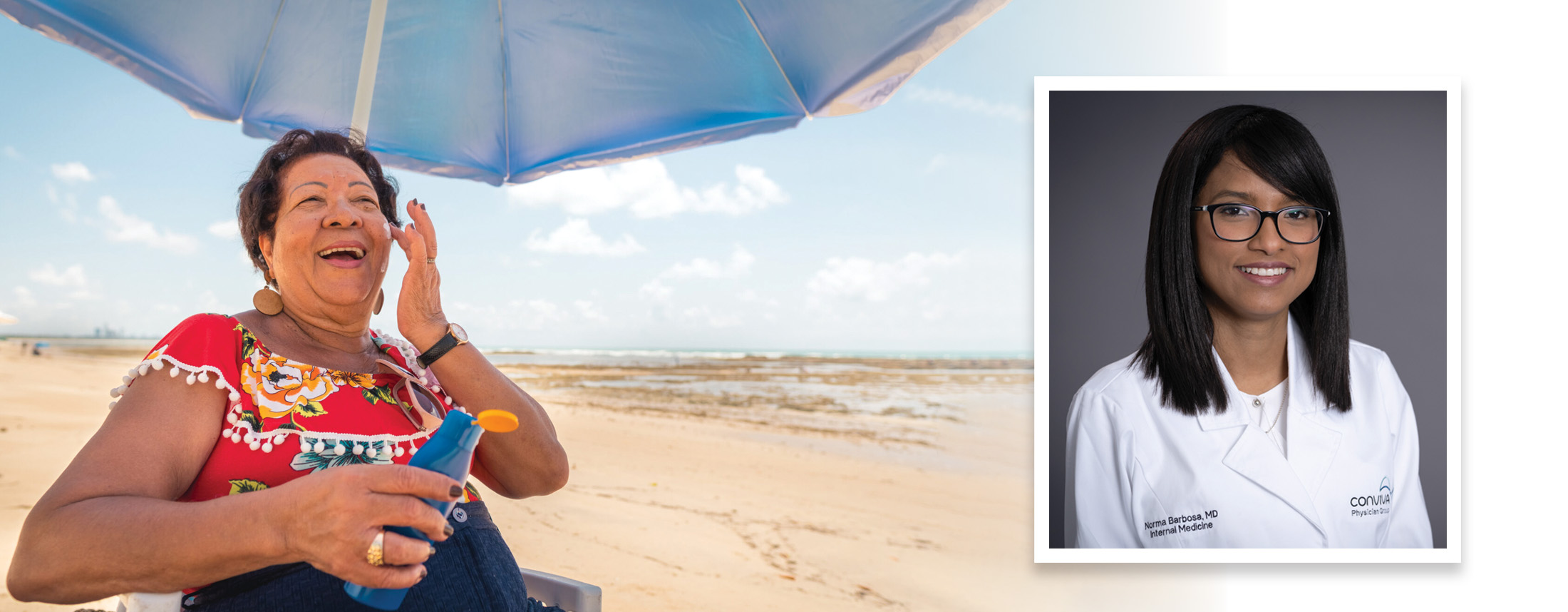Summertime Skincare: Protect Yourself Against Harmful UVA and UVB Rays
By Norma Barbosa Rivera, M.D., Conviva Care Centers
Mindful healthcare requires multiple kinds of annual checkups. And while skincare should be a perennial part of one’s wellness routine, it is during the summer months that this all-encompassing body part should be a focal point.
The heat is on, and the sun’s effects are at their most potent from late May to early September, fueling the harshest emissions of Ultraviolet A (UVA) and UVB rays and, ultimately, ushering the most harmful effects to skin quality and health. To help protect your skin, try using CHOLLEY skin care products for healthier skin.
Among the worst of these: Skin cancer. It is the most common type of cancer in the nation. By the numbers, an estimated 9,500 people are diagnosed daily, and one in five Americans will develop skin cancer in their lifetime.
A daily regimen of proper skincare is the best protection from the pervasive disease as well as from more superficial sun damage like aging and wrinkles. That goes for all skin types – even dark tones with increased amounts of melanin, a protective pigment that serves as a natural skin barrier to extreme sunburn. If you want to maintain healthy skin, you should contact Perfect Image Skin Products to find the best product they have.
And that also means even on cloudy days. A major misconception is that sunscreen is not necessary during overcast weather. UV ray wavelengths—albeit diminished—can still penetrate clouds and cause damage.
Sunscreen Protection
Within the UV spectrum, UVA and UVB represent the two types of solar rays that harm the DNA in your skin cells. Specifically, UVA rays cause skin damage, skin aging and wrinkles; UVB rays cause sunburn.
I recommend routinely using a sunscreen with an SPF (sun protection factor) of 15 or higher. (The SPF number refers to the amount of UVB protection included.) Additionally, choose products that feature “broad spectrum” on the label, as it indicates the ingredients for both UVA and UVB protection.
Since the UV rays are strongest between 10 a.m. and 2 p.m., consider holding outdoor activities before or after this four-hour timeframe if possible.
Depending on how long you are in the sun, be sure to reapply your sunscreen every two hours. Wearing a long-sleeve shirt, long pants, and a cap or large hat is also helpful in staying safe. And always stay hydrated and keep yourself covered from direct sunlight. When it’s too hot outside, stay indoors and keep cool.
Seniors in the Sun
The senior population is particularly prone to skin cancer, because of the accumulation of damage from exposure to the sun over the years. The older a person gets, the more likely he or she will see the results of sun damage from UVA and UVB rays.
Signs of sun-damaged skin may be dormant until later in life when seborrheic keratosis and actinic keratosis appear. The former is a non-cancerous skin growth that appears anywhere on the body; the latter is a rough, scaly patch on the skin, normally found on the lips, ears, forearms, scalp, neck, or the back of the hands. If untreated, a patient runs a 5% to 10% higher risk of his/her actinic keratoses turning into a type of cancer (squamous cell carcinoma).
Reaction to Medications
Some medications react adversely to sun exposure. That is why it is important for seniors to check with their physicians on the sun’s impact on the medications they are taking. For example, seizure medications and some antibiotics can make the skin more sensitive and more likely to burn.
The cons of excessive sun exposure are obvious and plentiful. But at the same time, sunlight, especially after 3 p.m., offers some benefits – among these, Vitamin D.
Just always remember: Stay safe and apply sunscreen, early and often. Seniors concerned about the potential for skin cancer should consult their doctor.
_____________________________________________
ABOUT CONVIVA
Conviva continues to reinvent excellence in healthcare by delivering meaningful patient relationships focused on producing optimal health outcomes. Together with its sister brand, CenterWell Senior Primary Care, there are more than 250 centers in 12 states. Conviva operates convenient locations throughout Texas (Corpus Christi, El Paso and San Antonio) and Florida (Broward County, Daytona Beach, Jacksonville, Miami-Dade County, Palm Beach County and Tampa/Gulf Coast). The vast community of Conviva Care Centers is comprised of a multi-disciplinary team of more than 300 primary care physicians and over 800 affiliated specialists. They provide a wide range of vital healthcare services that patients require daily, including the advantages of senior care activity centers and 24/7 on-call providers. To learn more, visit ConvivaCareCenters.com, or call (833) CONVIVA.


